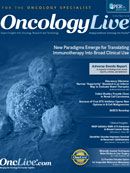Publication
Article
Oncology Live®
Novel Clinical Trial "Graduates" Two Promising Agents
Author(s):
The first results from the I-SPY 2 trial, which is evaluating novel agents in the neoadjuvant treatment of breast cancer, show encouraging possibilities for veliparib (ABT-888) and neratinib (PB272).
Photo Courtesy © SABCS/Todd Buchanan 2013
Hope S. Rugo, MD
The first results from the I-SPY 2 trial, which is evaluating novel agents in the neoadjuvant treatment of breast cancer, show encouraging possibilities for veliparib (ABT-888) and neratinib (PB272). The study employs a groundbreaking approach that may accelerate and influence the way that oncology drugs are tested and approved in the near future, leading researchers said during the 2013 San Antonio Breast Cancer Symposium.
The approach involves evaluating drugs in small study populations, using advanced statistical techniques that will promptly identify potentially successful cohorts. The investigators have label these drugs the “graduates,” which are then eligible to move into phase III testing, according to Hope S. Rugo, MD, a professor of medicine and director of Breast Oncology and Clinical Trials Education at the Helen Diller Family Comprehensive Cancer Center at the University of California, San Francisco. At the time of the conference, seven experimental regimens had been evaluated.
Rugo presented data on the oral PARP inhibitor veliparib in combination with carboplatin. Veliparib/ carboplatin improved pathologic complete response (pCR) rates in women with triple-negative breast cancer, thus qualifying the drug to move to the next round of clinical trial testing. In January, AbbVie launched a phase III trial in which 620 patients with early-stage, triple-negative breast cancer will be randomized to one of three arms: veliparib in combination with carboplatin and paclitaxel; placebo plus carboplatin/paclitaxel; or placebo plus paclitaxel (NCT02032277). Patients in all arms would follow these regimens with doxorubicin/ cyclophosphamide.
Neratinib, an irreversible tyrosine kinase inhibitor that blocks epidermal growth factor signaling, graduated after showing a probability of superiority as part of a combination regimen with paclitaxel followed by doxorubicin/cyclophosphamide in patients who are HER2-positive and hormone receptor-negative, according to Puma Biotechnology, Inc. The company said full results would be presented at a future scientific meeting.
The innovative, multidrug, phase II I-SPY 2 trial uses an adaptive design, based on biomarker subtypes, to evaluate a series of novel agents and combinations added to standard neoadjuvant therapy. The aim is to determine which types of patients respond best to particular therapies. Experimental regimens can “graduate” in at least one of 10 possible signatures defined by hormone receptor, HER2 status, and MammaPrint. “Our goal is to identify and graduate regimens that have at least an 85% Bayesian predictive probability of success in [future] 300-patient biomarker-linked phase III neoadjuvant trials,” said Rugo, who presented the results.
Peter Ravdin, MD, PhD, clinical professor of oncology in San Antonio, Texas, co-director of the symposium and moderator of the press conference where the results were presented, commented, “I-SPY 2 is not only positive, but it’s a new way of getting new drugs into clinical testing more rapidly. This is very important as our number of novel treatment options expands.”
Women with tumors ≥2.5 cm by clinical exam and ≥2.0 cm were eligible for screening, and those considered triple-negative (hormone receptor- [HR-] negative by low MammaPrint score and HER2-negative) were eligible for randomization to standard neoadjuvant chemotherapy—paclitaxel followed by anthracycline-based chemotherapy—or to paclitaxel plus a novel agent, followed by anthracycline-based chemotherapy before surgery.
The estimated pCR rate was 52% with veliparib/ carboplatin versus 26% with chemotherapy alone, with a 95% probability that this regimen is superior to the control, Rugo reported. The investigators were able to determine the combination’s potential after testing only 71 women, and after only 6 months of treatment. They predicted a 90% probability of success in a future trial of only 300 patients with this disease subtype.
In other “signatures,” the combination was predicted to be far less successful, according to Rugo. For example, in the HR-positive/HER2-negative group, the estimated pCR rate was 14% for the combination and 19% for controls. “The I-SPY 2 standing trial mechanism efficiently evaluates agents and combinations in biomarker-defined patient subsets. This adaptive trial successfully identified a biomarker signature/ drug pair for veliparib plus carboplatin on the basis of a modest number of patients,” Rugo said. “Veliparib/ carboplatin has graduated with the triple-negative signature, the subset recommended for this regimen’s Hope S. Rugo, MD subsequent development.” Abstract S5-02.










